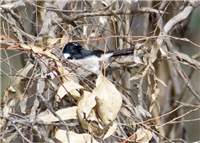Family
Dicruridae
Genus
Rhipidura
Species
leucophrys
Threats/Control Methods - Regional
This species does not appear to be affected by the regional land clearing in this area.
Threats/Control Methods - Local
Birds have adapted extremely well to the urban environment and are excellent at avoiding attacks by free roaming domestic pets.
Local/Urban Actions
Willie Wagtails are more likely to visit gardens with little threats of predation, with pet cats inhabiting indoor environments and enclosures.
Common Names
Willie Wagtail, Black-and-white Fantail, Black-and-white Flycatcher, Frogbird, Morning Bird, Shepherd's Companion, Australian Nightingale, Chitti Chitti, Tjitle Tjitle
Distinguishing Features
The Willie Wagtail has a black head, throat and body with white underparts. The only white on its head is in its distinctive white eyebrow that changes size with a bird's level of excitement. The long, black tail is often fanned and restlessly swung back and forth. Its legs are much longer than those of other fantails.
Survey Techniques
Call and visual identification.
Species Call
A scolding rattle of 'chicka-chicka-chika' or a pleasant, cheerful chatter.
Similar Species
This species is similar to the Grey Fantail (Rhipidura fuliginosa ), however wagtails are noticeably larger in size and are much more black.
Distribution
The Willie Wagtail is found in dominant numbers across all of Australia, excluding the northern tip of QLD and the southern half of TAS. They are also found in New Guinea, Solomon Islands, Bismarck Archipelago and the Moluccas.
Country of Origin
Australia
Conservation (Pet/Pest) Status - Regional
A gradual rise and fall in population numbers over the past 20 years indicates stability (COG).
Conservation (Pet/Pest) Status - National
Secure, not listed under the EPBC Act 1999. The Torres Strait population (Rhipidura leucophrys melaleucais) currently listed as Near Threatened, as it is confined to a small island population that may be at risk from rising sea levels in the near future.
LSCCES Population
High numbers were found at the NMA and BMP. Some were also found in Turner, Civic West and at ANU.
Associated vegetation community
Willie Wagtails prefer open country and woodland areas. They are also commonly seen in the urban environment in open parklands or school grounds.
Limiting Resources
The birds appear to survive best in areas of warm sunshine and clearings, with easy access to water in drier environments.
Breeding
The Willie Wagtail's nest is a neatly woven cup of grasses, covered with spider's web on the outside and lined internally with soft grasses, hair or fur. A clutch size is usually three cream speckled eggs, needing two weeks of incubation and two weeks in the nest. Both parents share the breeding season activities and up to four clutches can be raised in a single breeding season. The species spends time on the nest in October and dependant young are around from early December to late February.
Behaviour
Willie Wagtails use their eyebrows in territorial disputes. They will dive at rivals, chattering crossly and fluffing up the white feathers. The defeated bird will withdraw its eyebrow completely. Both male and female approach courtship with raised eyebrows. Around humans, the birds are very confident and cheerful. They will happily nest in and around houses and their gardens. They are also found around cattle and sheep, catching the insects that are attracted to the scent of the large animals or are distubed by their movements.
Functional Group
Food Species
They feed mostly on insects found on the ground or in low shrubs.
Predators
European Red Foxes (Vulpes vulpes), Dogs (Canis familiaris) and Cats (Felis catus) may attempt to attack this confident little bird, as may larger birds of prey. However, they are quite aggressive, especially in the breeding season and will bravely tackle predators several times their own size, such as Australian Magpies (Gymnorhina tibicen ) and Laughing Kookaburras (Dacelo novaeguineae ).
Interesting Fact
The Willie Wagtail features in many Aboriginal myths. In some regions, its killing is said to bring on violent storms, while in the NT the bird is considered a cunning spy and therefore ceremonial or private matters should not be discussed in its presence.
References - (reader suitability of references, P=Primary teachers, S=Secondary students, T=Tertiary students and researchers)
Books:Boles, W. 1988. The Robins and Flycatchers of Australia. Angus and Robertson Publishers. UK. P, S, T
Morcombe, M. 2000. Field Guide to Australian Birds. Steve Parish Publishing. Archerfield. Australia P, S, T
O'Grady, G. and Lindsay, T. 1979. Australian Birds and Their Young. Cassell Australia. NSW. P, S, T
Taws, N. et al. 2001. Bringing Birds Back: A Glovebox Guide for Bird Identification and Habitat Restoration in ACT and SE NSW. Greening Australia ACT and SE NSW Inc. P, S, T
Veerman, P. 2003. Canberra Birds: A report on the first 21 years of the garden bird survey. Philip Veerman and Canberra Ornithologists Group. Canberra. S, T
Internet: Birds in Backyards 2006. [online]. Available at:http://www.birdsinbackyards.net P, S, T
Canberra Ornithological Group (COG). 2004. Birds of Canberra Gardens. COG and the ACT Department of Urban Services. [online]. Available at:http://garden.canberrabirds.org.au/ P, S, T
Online Publications:Garnett, S. and Crowley, M. 2000. The Action Plan for Australian Birds 2000. Department of Environment and Water Resources. [online]. Available at: http://www.deh.gov.au/biodiversity/threatened/publications/action/birds2000/index.html S, T
Nix, H. and Cunningham, R. 2006. Birds of the Lower Sullivans Creek Catchment, Canberra ACT. Prepared for the Life in the Suburbs project using data from the Lower Sullivans Creek Catchment Ecological Survey (LSCCES). Australian National University. Canberra. [online]. Available at: http://www.lifeinthesuburbs.com.au/category.php?id=65 S, T
Wet Tropics Management Authority. 2001. Tropical Topics: Bird Body Language. Queensland Government. [online]. Available at:http://www.epa.qld.gov.au/register/p00820bu.pdfm P, S, T


 Top
Top Top
Top